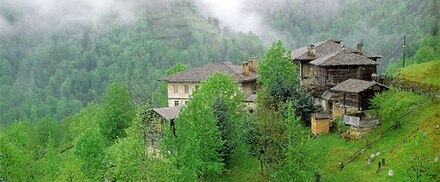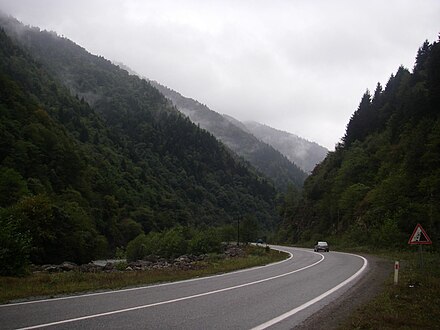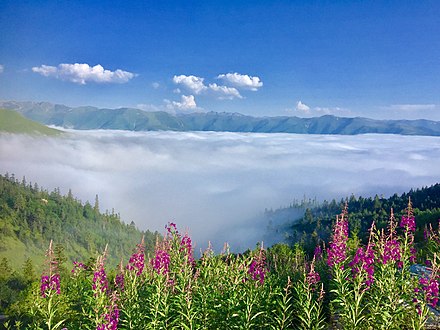Splendid forest scenery, stunning river gorges, misty alpine meadows, lush tea plantations, magnificent hillside monasteries, colossal cathedral ruins, forgotten mountain hamlets, lonely fishermen villages, ancient harbour towns, and fairy-tale castles all abound in Eastern Karadeniz (Turkish: Doğu Karadeniz), home to a local culture as rich as its biodiversity. Forming the easternmost third of the Turkish Black Sea coast, the region may feel remote, but is in fact efficiently accessible.
Cities
- Artvin, 41.1805136°, 41.80969°. home to a 10th-century fortress
- Ayder, 40.9538421°, 41.0979493°. village up in the lush Kaçkar Mountains/Pontic Alps
- Giresun, 40.915729°, 38.3911323°. city with a well-preserved citadel, an old town, and a lively nightlife; starting point for trips to the only Turkish island in the Black Sea
- Rize, 41.026322°, 40.5209061°. centre of the country's tea-growing region. Not a real tourist attraction, but a good base for exploring the northeast.
- Sürmene, 40.904382°, 40.1214505°.
- Tonya, 40.8813933°, 39.29575°. town up in the mountains known for its dairy products and the "wild west" reputation
- Torul, 40.5562041°, 39.2955322°. a hill town inland near to Zigana Pass
- Trabzon, 41.0011584°, 39.7179943°. biggest city and hub of the region
Other destinations
- Camili (Macahel). — a valley surrounded by steep mountains with six villages inhabited by Muslim Georgians, who decided in a 1921 referandum to join Turkey instead of then-Soviet Georgia. Due to the extreme biodiversity, the valley is a UNESCO Biosphere Reserve. In winter, when the local roads are regularly closed due to blizzards, the only access is from Georgia, practically making the area a Turkish exclave.
- Sümela Monastery. — the impressive monastery complex clinging high on a cliff is one of the highlights of any trip to the region.
Understand
 A humid and verdant region as a consequence of the very high precipitation distributed evenly throughout the year, the biodiversity of Eastern Karadeniz reaches the levels of tropical rainforests in some areas.
A humid and verdant region as a consequence of the very high precipitation distributed evenly throughout the year, the biodiversity of Eastern Karadeniz reaches the levels of tropical rainforests in some areas.
Eastern Karadeniz is the part of the region which Turks mostly think of when they hear Karadeniz, i.e. Black Sea. It includes the Artvin, Giresun, Gümüşhane, Rize, and Trabzon provinces.
People
Although all locals are colloquially, incorrectly, and somewhat derogatorily called "Laz" collectively by the Turks from elsewhere, Eastern Karadeniz, though overwhelmingly ethnically Turkish, has indeed a rich blend of ethnic make-up despite its relatively small size, like a microcosm of much larger multi-national former Ottoman Empire. In addition to the majority Turks, a number of towns east, west, and south of Trabzon are inhabited by Muslim Turks with a Pontic Greek background, though calling them "Greeks" outright may offend some of them (Muslim Greeks use the terms Rum or Romioi, meaning "Roman" or "Byzantine", to indicate their identity. Research has shown they are, however, very proud of their language and are happy to use it to converse with (Greek) tourists. Pontic Greek speakers live mostly in the districts of Çaykara, Sürmene, Tonya and İkizdere.
The Hemşin people, Muslimized brethren of Armenia, are present in the region, too, living in inland valleys south of Rize (however, most of the Hemshin people in Rize do not speak Armenian and do not regard themselves as Armenians). Around Hopa there is also a community of Hemşin who do speak Armenian and who have started teaching the Armenian alphabet to their children. Then there are the actual Laz people, distant cousins of Georgians, living in coastal towns east of Rize up to the Georgian border.
The inland far east of the region, i.e. Artvin and its surrounding area south of the Turkish-Georgian border, is inhabited by Georgians of Muslim background.
Most ethnic Turks in the central and eastern Karadeniz region belong to the Çepni boyu (clan), which is a distinct group from Anatolian Turks. The Çepni used to have their own states, which they established in the western Karadeniz region in former Pontic Greek cities after the battle of Manzikert, but eventually became part of the Ottoman Empire. Çepni culture thus has more influences by Pontic Greek, Caucasian and Persian culture, somewhat like that of the Azeri Turks.
Talk
The Bird Language
One of the most interesting linguistic features of the region is the Kuş dili, "bird language", a whistled language spoken by about 10,000 in Kuşköy and its vicinity near Giresun.
The Kuş dili speakers "translate" Turkish language words and sentences into high-pitched whistles and melodies. As with other whistling languages around the world, this is a response to the topography that surrounds their life: sheer mountain walls deeply cut by valleys, and whistling surely conveys sounds much further than yelling could ever hope for.
While there are effors to keep the language alive, such as offering it as an elective course in local schools, and to make it more widely known, by e.g. an annual festival dedicated to it running since 1997, many think it will go moribund, and will eventually die out, as it has lost its primary purpose due to the introduction of cell phones to the area in the early 2000s.
As aforementioned, there are very few pockets of people speaking Pontic Greek (locally known as Romeika, and which is not completely mutually intelligible with modern Greek as Pontic variant retains more of medieval/Byzantine Greek characteristics), Hemşin dialect of Armenian, Laz which is distantly related to Georgian spoken in the neighbouring country, and Georgian proper, although Turkish is sufficient to communicate whomever you are speaking to in the region. Locals speak Turkish in an accent that non-local Turks usually find "funny" and like to chaff at—indeed Eastern Karadeniz Turkish is a major theme in Turkish jokes folklore, but the local Turks dislike this stereotyping and find it offensive. Foreign languages spoken by minorities in the area are German, Russian, Dutch and Italian by elderly men, and English by the youth (English language courses are extremely popular in the coastal cities of the Eastern Black Sea region).
Get in
Trabzon is the main hub of transportation into the region.
- Trabzon is the site of the most important regional airport (IATA: TZX) with numerous daily domestic connections, although few flights are available from airports other than those of Istanbul and Ankara. Or-gi, built on an artificial island roughly mid-way between Ordu and Giresun (and bearing the name of those two cities) and Rize-Artvin, also built on reclaimed land between its namesakes, are other regional airports. Batumi Airport in neighbouring Georgia is also listed by Turkish Airlines as a domestic destination for the towns on the Turkish side of the border—travellers ticketed for the Turkish border towns are then taken by a bus across the border back into Turkey, without going through the customs and passport control.
- Trabzon, and Rize to a lesser degree, are served by frequent buses from rest of the country, especially big cities such as Istanbul and Ankara, as well as from Batumi. However, as the region lies at the far northeastern corner of the country, distances are huge and bus ride from, for example, Istanbul can easily take a full day and night.
- There are also some ferries from the Russian Black Sea Coast to Trabzon.
Get around

The highway D010, which has been upgraded to motorway standards, closely follows the coastline—sometimes too closely that it replaces the coastline as the motorway was built at cost of almost all of region's beaches, and forms the main backbone of transportation in the region from one end to another.
See
The hills and valleys of the eastern section of the region, around the valley of Çoruh, is dotted with ruins of Georgian churches and citadels, as the region was southern part of the medieval Georgian kingdom. Some of these churches and citadels are mostly intact while some others are almost totally ruined, and most lie on sites that are fairly off the beaten path.
Trabzon Province
- Kuştul Monastery (Turkish: Kuştul Manastırı, Greek: Ιερά Μονή του Αγίου Γεωργίου Περιστερεώτα), Trabzon Province (near Şimşirli village, 30 km southeast of Trabzon), 40.7964°, 39.6839°.
- Kaymaklı Monastery (Monastery of the All-Saviour, Ամենափրկիչ Վանք), Hizmet Cd., Trabzon suburb? (2 km East), 40.9943°, 39.74418°.
- Vazelon Monastery, Maçka district, Trabzon Province (40 km south of Trabzon), 40.7634°, 39.5327°. Founded in 270 AD. Now, ruined and abandoned
- Kızlar Monastery (Panagia Monastery, Kızlar Manastırı), Desen Sokak and Mht. Coşkun Karaağaçlı Cd. corner, Boztepe Mh., Trabzon, 40.9985°, 39.729°. Founded in 1360s. There is a rock church
- Pontic Mountains (Turkish: Kuzey Anadolu Dağları, meaning North Anatolian Mountains), Trabzon Province, 40.5°, 40.5°. Many trekking, hiking, possibility. Zil Castle, Palovit Waterfall
- Uzungöl (Saraho), Trabzon Province (99 km from Trabzon, 19 km from Caykara), 40.619°, 40.292°. A mountain lake at an altitude of 1090 m.
Rize Province
- Zilkale, Zilkale Village Way (Zilkale Köyü Yolu) (up the road past Şenyuva, up the road from Çamlıhemşin, just east of Ayder), 40.9283°, 40.95463°. — a beautiful ruined Byzantine-era castle, lost in the dense woods of a mountain valley.
Do

- Trekking in Kaçkar Mountains National Park (Kaçkar Dağları Milli Parkı), 40.833333°, 41.15°. between the hamlets and summer meadows (yayla) of the misty and lush Kaçkar Mountains is a popular activity.
- Caucasian Bullfighting Festival Area, 41.1666°, 41.7927°. The traditional bullfighting festival is known as Kafkasör and takes place on the third week of June every year.
Eat
The local people are known to be great lovers of local anchovy, hamsi, and experiment with incorporating it into just about anything, including delicious hamsi böreği, in which rice surrounded by anchovies all over is baked in the oven, and fairly unique hamsi tatlısı, which is a cake filled with anchovies, and topped by a concoction of fruits and sweet syrup.
Unlike the rest of the country, the main grain of local cuisine is corn, as wheat cannot stand to grow in the damp climate and rugged territory of the region. Corn flour is cooked into great breads, and muhlama, another local taste which basically consists of corn flour, butter, cheese, and salt.
Drink
Stay safe

Go next
- Central Karadeniz to west is the extension of the Black Sea coast, yet with fewer mountains and more plains.
- Eastern Anatolia to the south, just over the Pontic Mountains, is high territory with cold weather—even in summer—and is almost a world apart from the coast.
- Travellers heading further east enters Georgia's Black Sea coast via Sarpi border gate.